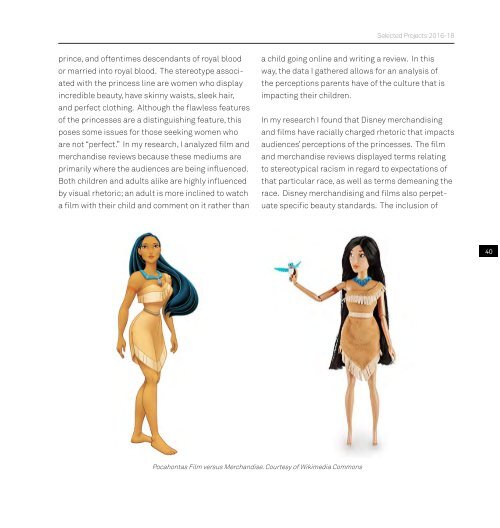Undergrad_Book_16-18_Pge_View_Print_no print marks_compressed
You also want an ePaper? Increase the reach of your titles
YUMPU automatically turns print PDFs into web optimized ePapers that Google loves.
Selected Projects 20<strong>16</strong>-<strong>18</strong><br />
prince, and oftentimes descendants of royal blood<br />
or married into royal blood. The stereotype associated<br />
with the princess line are women who display<br />
incredible beauty, have skinny waists, sleek hair,<br />
and perfect clothing. Although the flawless features<br />
of the princesses are a distinguishing feature, this<br />
poses some issues for those seeking women who<br />
are <strong>no</strong>t “perfect.” In my research, I analyzed film and<br />
merchandise reviews because these mediums are<br />
primarily where the audiences are being influenced.<br />
Both children and adults alike are highly influenced<br />
by visual rhetoric; an adult is more inclined to watch<br />
a film with their child and comment on it rather than<br />
a child going online and writing a review. In this<br />
way, the data I gathered allows for an analysis of<br />
the perceptions parents have of the culture that is<br />
impacting their children.<br />
In my research I found that Disney merchandising<br />
and films have racially charged rhetoric that impacts<br />
audiences’ perceptions of the princesses. The film<br />
and merchandise reviews displayed terms relating<br />
to stereotypical racism in regard to expectations of<br />
that particular race, as well as terms demeaning the<br />
race. Disney merchandising and films also perpetuate<br />
specific beauty standards. The inclusion of<br />
40<br />
Pocahontas Film versus Merchandise. Courtesy of Wikimedia Commons



